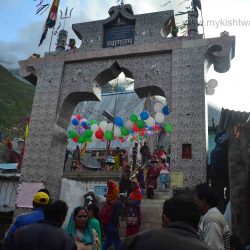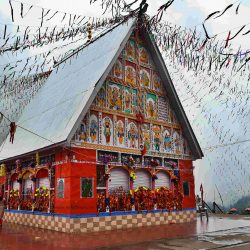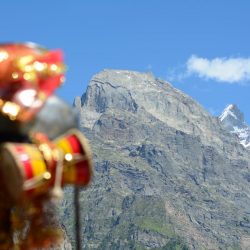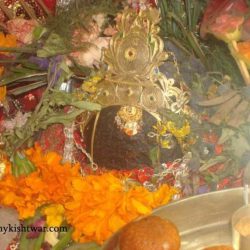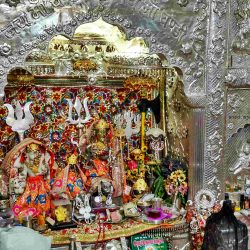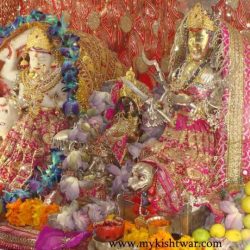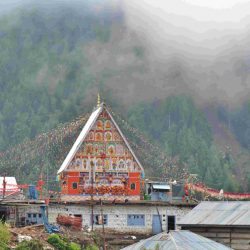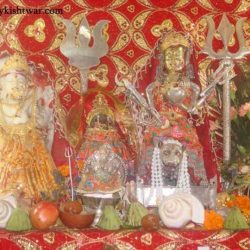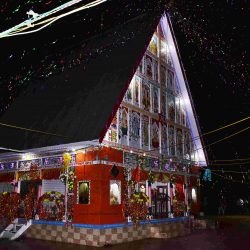Wednesday, July 31, 2024
मेहंदीपुर बालाजी मंदिर
Wednesday, July 17, 2024
Ram or Ramban
Monday, July 8, 2024
Shiva Cave Chenani
Sunday, July 7, 2024
Jagannath Rath Yatra

Jagannath Rath Yatra 2024 news LIVE: The annual Lord Jagannath's Rath Yatra will begin in Odisha's Puri today. This year, due to specific celestial arrangements, the religious event will go on for two days. President Droupadi Murmu is expected to witness the Rath Yatra in Puri, along with millions of devotees from across India.
The Odisha government has made elaborate arrangements for smooth and timely conduct of the annual festival. Special security arrangements will be in place for the President’s visit to the festival. While a VIP zone has been planned for the Odisha governor, chief minister, Union ministers and other dignitaries, a buffer zone has been planned for the President, ADG (law and order) Sanjay Kumar told news agency PTI.
Usually a one-day religious event, the Rath Yatra was last held for two days in 1971. During the Yatra, rituals related to the Hindu deities - Lord Jagannath, Devi Subhadra and Lord Balabhadra - take place.
Also known as the Chariot Festival, the Yatra marks the Holy Trinity's journey to their maternal aunt, Goddess Gundicha Devi's Temple, and concludes with their return after eight days. Ahead of the Yatra, the chariots have been parked in front of the Lion's Gate of the Jagannath temple from where they would be taken to Gundicha temple where the Raths will stay for a week.
Jagannath Rath Yatra 2024 news LIVE: President Droupadi Murmu wishes people
Jagannath Rath Yatra 2024 news LIVE: "On the occasion of the world famous Rath Yatra of Lord Jagannath, I extend my heartfelt best wishes to all the countrymen. Today, countless Jagannath-lovers from all over the country and the world are eagerly waiting to see the three forms of Bhagavat seated on the chariot. On the occasion of this great festival, I pray to Mahaprabhu Shri Jagannath for everyone's happiness, peace and prosperity. Hail Jagannath!," posted the President of India on social media X.
Jagannath Temple, Puri
The Jagannath Temple is a Hindu temple dedicated to the god Jagannath, a form of Vishnu in Hinduism. It is located in Puri in the state of Odisha, situated on the eastern coast of India. As per temple records, King Indradyumna of Avanti built the main temple of Jagannath at Puri.[2] The present temple was rebuilt from the tenth century onwards, on the site of the pre-existing temples in the compound, but not the main Jagannath temple, and begun by Anantavarman Chodaganga, the first king of the Eastern Ganga dynasty.[3] Many of the temple rituals are based on Oddiyana Tantras which are the refined versions of Mahayana Tantras as well as Shabari Tantras which are evolved from Tantric Buddhism and tribal beliefs respectively. The local legends link the idols with aboriginal tribes and the daitapatis (servitors) claim to be descendants of the aboriginals.[4] The temple is one of the 108 Abhimana Kshethram of the Vaishnavite tradition.
The temple is famous for its annual Ratha Yatra, or chariot festival, in which the three principal deities are pulled on huge and elaborately decorated raths, or temple cars. The worship is performed by the Bhil Sabar tribal priests, as well as priests of other communities in the temple.[5] Unlike the stone and metal icons found in most Hindu temples, the image of Jagannath is made of wood, and is ceremoniously replaced every 12 or 19 years by an exact replica.[6] The temple is one of the Char Dham pilgrimage sites. It is also famous because many legends believe that Krishna's heart was placed here, and the material that it is made from damages the heart, so they have to change it every seven years.[7]
The temple is sacred to all Hindus, and especially in those of the Vaishnava traditions. Many great Vaishnava saints, such as Ramanujacharya, Madhvacharya, Nimbarkacharya, Vallabhacharya and Ramananda were closely associated with the temple.[8][9] Ramanuja established the Emar Matha in the south-eastern corner of the temple, and Adi Shankaracharya established the Govardhan Math, which is the seat of one of the four Shankaracharyas. It is also of particular significance to the followers of Gaudiya Vaishnavism, whose founder, Chaitanya Mahaprabhu, was attracted to the deity, Jagannath, and lived in Puri for many years.[10][11]
History
The temple was rebuilt by the King of the Eastern Ganga dynasty, Anantavarman Chodaganga, in the 10th century CE, as described by the Kendupatna copper-plate inscription of his descendant, Narasimhadeva II and Rajendra Chola from the mother side.[1] Anantavarman was originally a Shaivite, and became a Vaishnavite sometime after he conquered the Utkala region, in which the temple is located, in 1112 CE. A 1134–1135 CE inscription records his donation to the temple. Therefore, the temple construction must have started sometime after 1112 CE.[12]
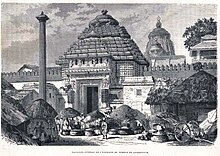
According to a story in the temple chronicles, it was founded by Anangabhimadeva II. Different chronicles variously mention the year of construction as 1196, 1197, 1205, 1216, or 1226.[13] This suggests that the temple's construction was completed or that the temple was renovated during the reign of Anantavarman's son, Anangabhima.[14] The temple complex was further developed during the reigns of the subsequent kings, including those of the Ganga dynasty and the Gajapati dynasty.[15]
The temple annals, the Madala Panji, records that the Jagannath temple has been invaded and plundered eighteen times.[16] The temple is believed to have been attacked by Kalapahad, a Muslim convert general, in the 16th century.[17]
Deities
Jagannath, Subhadra and Balabhadra are a trio of deities worshipped at the temple. The inner sanctum of the temple contains the deities of them carved from sacred neem logs, known as daru sitting on the bejewelled platform or ratnabedi, along with the deities of Sudarshana Chakra, Madanmohan, Sridevi and Vishwadhatri.[18] The deities are adorned with different clothing and jewels according to the season. Worship of these deities predates the building of the temple, and may have originated in an ancient tribal shrine.[19] The oldest mention of the deity is in the Oddiyana Vajrayāna Tantric text Jñānasiddhi by Indrabhuti, which opens with an invocation of Jagannath.[20][note 1] Sarala Das in his Sarala Mahabharata identified Jaganath with Buddha in Adi Parva and Madhya Parva.[note 2]
Legends

According to legends in Madala Panji, the construction of the first Jagannath temple was commissioned by King Indradyumna, a Malava king, mentioned in the Mahabharata and the Puranas.[23]
Indradyumna put up for Jagannath to build the tallest monument in the world. It was 1,000 cubits (457.2 metres) high. He invited Brahma, the cosmic creator, consecrate the temple and the images.[24]
The traditional story concerning the origins of the Jagannath temple is that the original image of Jagannath at the end of the Dvapara Yuga, was manifested near a banyan tree, near the shore in the form of an Indranila Mani, or the Blue Jewel. It was so dazzling that it could grant an instant moksha, so the god Dharma, wanted to hide it in the earth, and was successful. In the Kali Yuga, Indradyumna wanted to find that mysterious image, and to do so, he performed harsh penance to obtain his goal. Vishnu then instructed him to go to the seashore of Puri, and find a floating log to make an image from its trunk.[25][26]
Then, Indradyumna found the log of wood. He did a yajna, from which Narasimha appeared and instructed that Narayana should be made as a four-fold expansion, i.e., Paramatma as Vasudeva (Krishna), his Vyuha as Samkarshana (Balabhadra), his Yogamaya as Subhadra, and his Vibhava as Sudarshana. After this, Vishwakarma appeared in the form of an artisan and prepared images of Jagannath, Balabadra and Subhadra from the tree.[27]
When this log, radiant with light, was seen floating in the sea, Narada told the king to make three deities out of it and place them in a pavilion. Indradyumna got Vishwakarma, the architect of gods, to build a magnificent temple to house the deities, and Vishnu himself appeared in the guise of a carpenter to make the deities, on condition that he was to be left undisturbed until he finished the work.[25][28]
But just after two weeks, the queen of Indradyumna became very anxious. She took the carpenter to be dead as no sound came from the temple. Therefore, she requested the king to open the door. Thus, they went to see Vishnu at work, at which the latter abandoned his work, leaving the deities unfinished. The deity was devoid of any hands. But a divine voice told Indradyumna to install them in the temple. It has also been widely believed that in spite of the deity being without hands, it can watch over the world and be its lord. Thus, the idiom.[25][28]
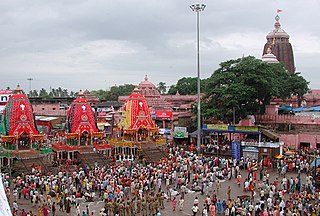
Entry and Darshan
Non-Hindus (excluding Jains, Sikhs, Buddhists) and foreigners are not permitted to enter the temple.[29][30] Such a rule is believed to exist ever since the temple was built, and at present, it often becomes a subject to controversy and debates that have lasted for several decades.[31][32][33] According to Ganeshi Lal, the former Governor of Odisha, foreigners can enter the temple only if he/she can meet the Gajapati servitors and the Shankaracharya, then he/she could also be allowed to witness Jagannath. But, this theory has not wielded influence yet, and continues to be a subject of longstanding debate.[34] The temple is open everyday from 5:00 am to 10:30 pm.[35]
Cultural integrity
Starting from Jagannath himself, history has it that he was a tribal deity, adorned by the Bhils and Sabar people, as a symbol of Narayana. Another legend claims him to be Nilamadhava, an image of Narayana made of blue stone and worshipped by the tribals. He was brought to Nilagiri, theblue mountain, or Nilachala, and installed there as Jagannath, in company with Balabhadra and Subhadra. The images made of wood are also claimed to have their distant linkage with the Vanvasis, or forest dwellers, as a system of worshipping wooden poles. To cap it all, the Daitapatis, who have a fair share of responsibilities to perform rituals of the temple, are claimed to be descendants of the hill tribes of Odisha, also believed to be a close relative of Jagannath. Hence, the beginning of the cultural history of Shrikshetra, known as the cultural capital of Odisha is found in the cultures of Hindu tribes. The three deities came to be claimed as the symbols of Samyak Darshan, Samyak Jnana and Samyak Charita, usually regarded as Ratnatraya, the triple gems of the Jain culture, assimilation of which leads to omniscience and Moksha (salvation).[36]
Acharyas and Jagannatha Puri
All of the renowned acharyas, including Madhvacharya, have been known to visit this kshetra. Adi Shankaracharya established his Govardhan Math here. Guru Nanak had visited this place with his disciples, Bala and Mardana. Chaitanya Mahaprabhu of Gaudiya Vaishnavism stayed here for 24 years, declaring that the love of God can be spread by chanting the Hare Krishna mantra. Vallabha visited the temple and performed a 7-day recitation of the Srimad Bhagavata. His sitting place is still famous as his baithakji, literally translating to his seat. It confirms his visit to Puri.[37]
Some of the pandits who participated became jealous of the young Vallabha, and wanted to test him. The next day was Ekadashi, a fasting day where one must fast from grains. The pandits gave Vallabha rice prasad of Lord Jagannath, for which the temple is still famous. If Vallabha ate it, he would break his vow of fasting, but, if he did not take it, he would disrespect Jagannath. Hence, Vallabha, with all honour and respect, accepted the prasad in his hand. He stood there in the temple, spent the rest of the day and night, explaining the shlokas of the greatness of prasad, and ate the prasad the next morning after sunrise.[38]
The Sikh aarti, Gagan mein thaal, was recited by the first Sikh guru, Guru Nanak, in 1506 or 1508,[39][40][41][42] during his journey, called udasi, to east India,[40][41] at the revered Jagannath Temple, Puri. This aarti is only sung, not performed with any platter and/or lamps, etc.
Char Dham
The temple is one of the holiest Vaishnava Hindu Char Dham sites, the four divine pilgrimage sites, the other being Rameswaram, Badrinath and Dwarka.[43] Though the origins are not clearly known, the Advaita school of Hinduism propagated by Adi Shankaracharya, who created Hindu monastic institutions across India, attributes the origin of Char Dham to the seer.[44] The four temples lie across the four cardinal points, or four corners of India, and their attendant temples are Badrinath Temple at Badrinath in the north, Jagannath Temple at Puri in the east, Dwarakadheesh Temple at Dwarka in the west and Ramanathaswamy Temple at Rameswaram in the south. Though ideologically, the temples are divided between the sects of Hinduism, namely Shaivism and Vaishnavism, the four pilgrimage sites are fully Hinduism.[45] There are four abodes in the Himalayas, called Chota Char Dham (lit. "the small four abodes/seats"): Badrinath, Kedarnath, Gangotri and Yamunotri – all of these lie at the foothills of the Himalayas, in the state of Uttarakhand.[citation needed] The journey across the four cardinal points of India is considered sacred by Hindus, who aspire to visit these temples at least once in their lifetime. Traditionally, the trip starts at the eastern end from Puri, proceeding in a clockwise direction, in a manner typically followed for circumambulation in Hindu temples.[46]
Structure

The temple complex covers an area of over 37,000 square metres (400,000 sq ft), and is surrounded by high fortified wall. This 6.1 metres (20 ft)-high wall is known as Meghanada Pacheri.[47] Another wall known as kurma bedha surrounds the main temple.[48] It contains at least 120 temples and shrines. With its sculptural richness and fluidity of the Kalinga architecture, it is one of the most magnificent temples of India.[49] The temple has four distinct sectional structures, namely–Deula, Vimana or Garbhagriha (sanctum sanctorum), where the triad deities are lodged on the ratnavedi, or throne of pearls. In Rekha Deula style, there is the Mukhashala, (frontal porch), the Natamandapa, also known as the Jagamohan (audience/dancing hall), and the Bhogamandapa (offerings hall).[50] The main temple is a curvilinear temple, and crowning the top is the Neelachakra, an eight-spoked wheel of Vishnu. It is made out of Ashtadhatu, an alloy of eight metals, and is considered sacrosanct.[51] Among the existing temples in Odisha, the temple of Lord Jagannath is the highest. The temple tower was built on a raised platform of stone, rising to a height 65 metres (214 ft), above the inner sanctum where the deities reside, dominates the surrounding landscape. The pyramidal roofs of the surrounding temples and adjoining halls, or mandapas, rise in steps toward the tower, like a ridge of mountain peaks.[52]
Nila Chakra
The Nila Chakra (lit. blue discus) is the discus mounted on the top of the shikhara of the Jagannath temple. As per custom, everyday a different flag is waved on the Nila Chakra. The flag hoisted on the Nila Chakra is called the Patita Pavana (lit. "Purifier of the Fallen"), and is equivalent to the image of the deities placed in the sanctum sanctorum.[53]
The Nila Chakra is a disc with eight Navagunjaras carved on the outer circumference, with all facing towards the flagpost above. It is made up of Ashtadhatu and is 3.5 metres (11 ft) high, with a circumference of about 11 metres (36 ft).[54]
The Singhadwara

The Singhadwara, which in Sanskrit means "The Lion Gate", is one of the four gates to the temple, and forms the main entrance. The Singhadwara is so named because of two huge statues of crouching lions existing on either side of the entrance. The gate faces eastward, opening on to the Bada Danda or the "Grand Road".[55] The Baisi Pahacha, or the flight of twenty-two steps, leads into the temple complex. A deity of Jagannath known as Patita Pavana, which in Sanskrit means the "saviour of the downtrodden and the fallen", is painted on the right side of the entrance. In ancient times, when untouchables were not allowed inside the temple, they could pray to the Patita Pavana. The statues of the two guards to the temple, Jaya and Vijaya, stand on either side of the doorway.[56] Just before the commencement of the Ratha Yatra, the deities of Jagannath, Balabhadra and Subhadra are taken out of the temple through this gate. On their return from the Gundicha Temple, they have to ceremonially placate Goddess Lakshmi, whose deity is carved atop the door, for neglecting to take her with them on the Yatra. Only then, the goddess allows them permission to enter the temple. A magnificent sixteen-sided monolithic pillar, known as the Aruna Stambha, stands in front of the main gate. This pillar has an idol of Aruna, the charioteer of the sun god, Surya, on its top. One notable fact about the Aruna Stambha is that prior to its current location, it was located in the Konark Sun Temple.[57][58] Later, the Maratha guru, Brahmachari Gosain, brought this pillar from Konark.[59]
Other entrances

Apart from the Singhadwara, which is the main entrance to the temple, there are three other entrances facing north, south and west. They are named after the sculptures of animals guarding them. The other entrances are the Hathidwara or the Elephant Gate, the Vyaghradwara or the Tiger Gate and the Ashwadwara or the Horse Gate.[60]
Minor temples
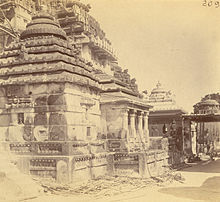
There are about thirty smaller temples and shrines within the Temple complex where active worship is regularly conducted.[60]There are some temples are considered significant and generally visited before the main temple of Jagannath:.[60] the Ganesha temple near the kalpavata banyan tree, Vimala Temple, Nilamadhaba temple, Gopalaballava temple and Lakshmi temple.
The Vimala Temple (Bimala Temple) is considered one of the most important of the Shaktipeeths.[60] It is located near Rohini Kund in the temple complex. Until food offered to Jagannath is offered to goddess Vimala it is not considered Mahaprasad.[60] The temple of Lakshmi, the consort of Jagannath, has an important role in rituals of the main temple.[60]
There are other shrines dedicated to Kanchi Ganesha, Shiva, Surya, Saraswati, Bhuvaneshwari, Narasimha, Rama, Hanuman.[60]
The Mandapas

There are many mandapas, or pillared halls on raised platforms within the temple complex meant for religious congregations. The most prominent is the Mukti Mandapa, the congregation hall of the holy seat of selected literate Brahmins.[61]
Daily food offerings
Daily offerings are made to the deity six times a day. These include:
- The offering to the deity in the morning that forms his breakfast, and is called Gopala Vallabha Bhoga. It consists of seven items i.e., Khoa, Lahuni, sweetened coconut grating, coconut water, and popcorn sweetened with sugar known as Khai, curd and ripe bananas.
- The Sakala Dhupa forms his next offering at about 10 am. This generally consists of 13 items, including the Enduri pitha and the Mantha puli.
- The Bada Sankhudi Bhoga forms the next offering, consisting of Pakhala with curd and Kanji payas. The offerings are made in the Bhog Mandapa, about 61 metres (200 ft) from the Ratnabedi. This is called the Chatra Bhog, which was introduced by Adi Shankaracharya in the eighth century to help pilgrims share the temple food.
- The Madhyanha dhupa forms the next offering at the noon.
- The next offering to the deity is made in the evening at around 8 pm, known as Sandhya Dhupa.
- The last offering to the deity is called the Bada Singhara Bhoga.[62]
Rosaghara
The temple's kitchen is the second largest in the world.[49][63][64][65] Tradition holds that all the Mahaprasad that is cooked in the temple kitchen is supervised by Goddess Lakshmi, the empress of the temple herself, and that if the food prepared has any fault in it, a shadow dog appears near the temple kitchen, a sign of her displeasure. If the shadow dog is seen, the food is promptly buried and a new batch is cooked.[66] All 56 varieties of food produced are vegetarian and prepared without onions and garlic.[67]
Festivals

There are elaborate daily worship services. There are many festivals each year attended by millions of people. The most important festival is the Ratha Yatra, or the chariot festival, in June or July. This spectacular festival includes a procession of three huge raths, or chariots, bearing the deities of Jagannath, Balabhadra and Subhadra through the Bada Danda, or the Grand Avenue of Puri, until their final destination to the Gundicha Temple.[68] Others are Pana Sankranti, also known as Vishuva Sankranti and Mesha and Sankranti, in which special rituals are performed at the temple.[69]
Anavasara or Anasara
Every year, the main deities of Jagannath, Balabhadra, Subhadra and Sudarshan, after the holy Snana Yatra on the Jyeshtha Purnima, go to a secret altar, named Anavasara Ghar, where they remain for the next dark fortnight, or Krishna paksha. Hence, devotees are not allowed to view them. So devotees worship at the nearby temple of Alarnath at Brahmagiri, an icon of a four-handed Vishnu, as a manifestation of Jagannath.[70] Devotees get the first glimpse of the deities on the day before Ratha Yatra, which is called Navayouvana. It is said that the deities fall in fever after taking a huge bath, and they are treated by the special servants, named Daitapatis, for 15 days. During this period, cooked food is not offered to the deities.[71]
Ratha Yatra at Puri
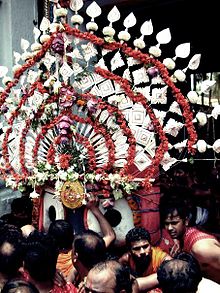
The Jagannath triad are usually worshipped in the sanctum sanctorum of the temple at Puri, but during the month of Ashadha, or the monsoon month, usually falling in month of June or July, they are brought out onto the Bada Danda, or the divinity street, and travel (3 km) to the Gundicha Temple, in huge chariots, or raths, allowing the public to have the Darshana, or the holy view of the deities. This festival is known as Ratha Yatra, meaning the journey (yatra) of the chariots (raths). The Rathas are huge wheeled wooden structures, which are built anew every year and are pulled by the devotees with ropes. The chariot for Jagannath is approximately 14 metres (45 ft) high and 11 metres (35 ft) wide, and takes about 2 months to construct.[72] The artists and painters of Puri decorate the cars and paint flower petals and other designs on the wheels, the wood-carved charioteer and horses, and the inverted lotuses on the wall behind the throne.[73] The huge chariots of Jagannath pulled during Ratha Yatra is the etymological origin of the English word 'Juggernaut'.[74] The Ratha Yatra is also termed as Shri Gundicha Yatra.[75]
The most significant ritual associated with Ratha Yatra is the Chhera Pahara (lit. sweeping with water). During the festival, the Gajapati king wears the outfit of a sweeper, and sweeps all around the deities and their chariots in the Chhera Pahara ritual. The Gajapati king cleanses the road before the chariots with a gold-handled broom, and sprinkles sandalwood water and powder with utmost devotion. As per the custom, although the Gajapati King has been considered the most exalted person in the Kalinga kingdom, he still renders the menial service to Jagannath. This ritual signified that under the lordship of Jagannath, there is no distinction between the powerful sovereign Gajapati king and the most humble devotee.[76]

Moreover, the ruling dynasty instituted the Ratha Yatra at the completion of the great temple around 1150 AD. This festival was one of those Hindu festivals that was reported to the Western world very early. Odoric of Pordenone, a Franciscan friar from Pordenone in modern Italy, visited India in 1316–1318, some 20 years after Marco Polo had dictated the account of his travels while in a Genoese prison.[77][78] In his own account of 1321, Odoric reported how the people put the deities on chariots, and the King, Queen and all the people drew them from the "church" with song and music.[79][80]
Niladri Bije
Celebrated on Ashadha Trayodashi,[81] Niladri Bije is the concluding day of Ratha Yatra. On this day, deities return to the Ratnabedi.[82][83] Here, Jagannath offers Rasgulla to Goddess Lakshmi to enter into the temple.[84][85]

Gupta Gundicha
It is celebrated for 16 days from Ashwin month's Krishna dwitiya to Vijayadashami.[86] As per tradition, Madhava, along with Durga, (known as Durgamadhaba), is taken on a tour of the temple premises. The tour within the temple is observed for the first eight days. For the next eight days, the deities are taken outside the temple on a palanquin to the nearby Narayani temple situated in the Dola mandapa lane. After their worship, they are brought back to the temple.[87]
Nabakalebara
Nabakalabera is a ritual associated with Jagannath,[88] which takes place every 8, 12 or 19 years, when one lunar month of Ashadha is followed by another lunar month of Ashadha. Meaning "New Body", the ritual involves installation of new images in the Jagannath Temple and the burial of the old images at the temple at Koili Vaikuntha. The festival is witnessed by millions of people and its budget exceeds ₹41,000,000 (US$490,000).[89] More than three million devotees are estimated to have visited the temple during the Nabakalevara in 2015, making it one of the most visited festivals in the world.[90]
Management
After independence, the Government of Odisha, with a view to getting better administrative system, passed "The Puri Shri Jagannath Temple (Administration) Act, 1952".[91]
Dibyasingha Deba, the incumbent Gajapati king and King of Puri, is the current adhyasevak (chief servitor) of the temple.[92][93] He took the role in 1970 at the age of 17, after the death of his father, Birakishore Deb, then King of Puri.[94]


Security
The security at the temple has increased ahead of Ratha Yatra, the homecoming festival of the deities of Jagannath temple. In the wake of terror alert on 27 June 2012, the security forces were increased to ensure smooth functioning of the crowded Ratha Yatra and Suna Besha.[95] As part of the modernisation of the temple premises and surroundings, the temple's security force has been further advanced, such as 44 police platoons with 30 police officers each, and 135 CCTV cameras with advanced face-scanning technology have been installed in the premises, to cater to more pilgrims and visitors and provide them with enhanced security.[96]
Shree Jagannath Heritage Corridor
The "Shree Mandir Parikrama", also known as the Shree Jagannath Heritage Corridor (SJHC), is a 75-metre-long corridor around the Jagannath temple. It has been built to provide expansive and unobstructed corridors around the Meghanad Pacheri for giving an opportunity to devotees and pilgrims to have better darshan with the Temple, Nila Chakra and Meghanad Pacheri, similar to the Kashi Vishwanath Corridor of the Kashi Vishwanath Temple in Varanasi. The corridor provides several facilities and amenities for giving pilgrims and visitors a hassle-free and memorable experience, and for strengthening safety and security of the temple and the devotees.[97] Construction began on the corridor after Chief Minister Naveen Patnaik and the incumbent King of the Gajapati Empire and of Puri, as well as the adhyasevak, or the chief servitor of the Jagannath temple, Dibyasingha Deba, laid the foundation stone for it in November 2021.[98] It was inaugurated and opened to the public by Chief Minister Naveen Patnaik and King Dibyasingha Deba on 17 January 2024.[99]
Friday, July 5, 2024
You are here Home > Religious Places > Machail Mata Paddar Machail Mata Paddar
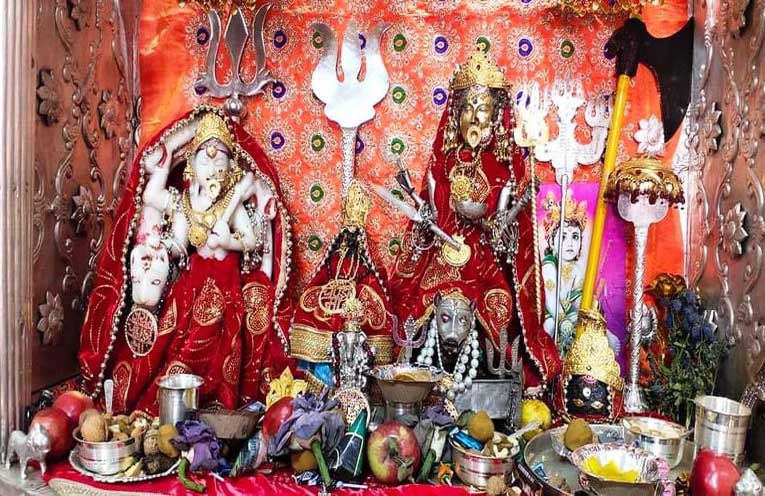
A mace or Holi Chhari of Goddess Chandi Mata is taken out by the devotees from village Chinote Bhaderwah, the home village of Thakur Kulbir Singh. Under his auspicious control a procession is taken to Machail with people singing bhajans in praise of the goddess amidst beating of drums, playing upon flutes and chanting of mantras. Now a days the yatra is also taken out from Jammu.

A mace or Holi Chhari of Goddess Chandi Mata is taken out by the devotees from village Chinote Bhaderwah, the home village of Thakur Kulbir Singh. Under his auspicious control a procession is taken to Machail with people singing bhajans in praise of the goddess amidst beating of drums, playing upon flutes and chanting of mantras. Now a days the yatra is also taken out from Jammu.
CLICK HERE TO LISTEN TO BHAJANS OF MAA CHANDI
The river Chandra and Bhaga confluences at Atholi and while traversing this long stretch of 30 kms, you follow proud Bhaga sometimes accompanying you and sometimes going against your track with roaring echoes and foaming fury watery flames so gorgeously against perpendicular rocks. The Chhari starts from Bhadarwah town itself and this year this Chhari started from Bhadarwah on 19th August on foot led by the Pujari of Bhadarsah temple accompanied by the delighted devotees.
While on way, you come across many
villages and hamlets on the left and right, though of course,
unreachable and of the few hamlets are Matti, Seondi, Hamiddran, Massu,
Mao, Garh, Naral, Sugliangadi, Bathree, Mulgo, Shagaani, Kokandran,
Rotae, Palelee, Betha and a big village ligree having hamlets viz,
Doordo, Stangarhi, Thatak, Shahalee, Totee, Pondale, Tunkhel, etc. etc.
This village ligree is having a population around 1000 or so. It is a
matter of pity that the educational front is very poor due to the
inaccessibility of the area and there is no schooling above metric
level.
The entire belt is often surrounded by
hot and cold springs which flow intermittently and some, of course, are
perennial and these springs are called miracles of nature and these
springs are considered as most sacred and meritorious. On reaching
Machail a small village, rather hamlet is located at the sacred shrine
of Mata Chandi depicted in the main photo and the devolve throng in
queues for hours together to have a holy darshan of Mataji pay obedience
and obtain blessings.
Though it may seem strange, but too true that lord Shiva is quite glitteringly with his consort Mata Parvati, through the rock is perpendicularly perched upon a very hard bed, not as yet reachable. This pious spot is located in the backdrop of the sacred shrine of Chandi Mata. Miraculous is the ways of the Gods and Goddesses who alone can well understand the mysteries of the vast, varied cosmic universe.
Machail Yatra attracts many visitors. Now with the increasing focus on Bhadarwah as a pilgrim and tourist spot, the civil amenities for this religious spot need to be undertaken on a war footing. Toilet blocks, the road up gradation plantation, rain shelters, and retaining walls at steep points have to incorporate in the developmental plan for Machail Mata Shrine. Then an increasing number of people will visit it to get spiritual peace. It will give a boost to the local economy which is hard-pressed at present.


